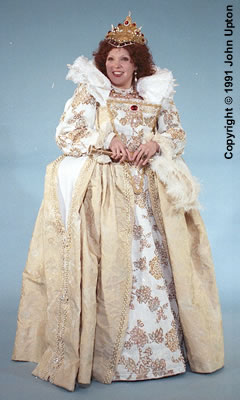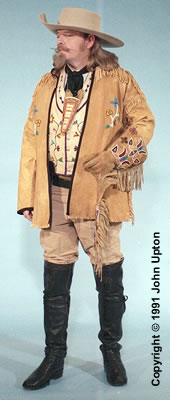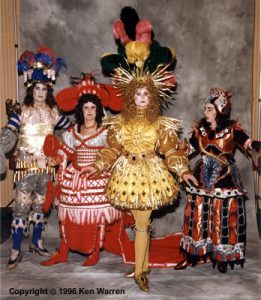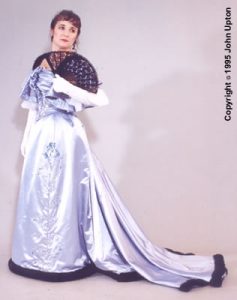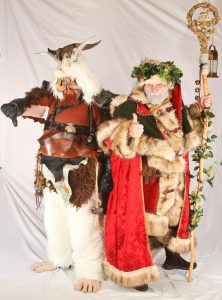CC09-H-15a: Frontiersman (c. 1880)
CC09-H-15a: Frontiersman (c. 1880)n | Division: Journeyman | Category: Hist. Reproduction | Designer(s): Elizabeth Pidgeon-Ontis | Maker(s): Elizabeth Pidgeon-Ontis | Presenter(s): Carl Ontis | Workmanship Award(s): Best in Show (Workmanship) - tie (Photo ID: John Upton | Event Date: 1991)
Competition Staff & Rules
Historical Masquerade Rules and Divisions
Historical Reproduction Masquerade Staff:
- Masquerade Director: Barb Schofield
- Master of Ceremonies: Ricky Dick
- Presentation Judges: Peggy Kennedy‡, Jennifer Ketcham, George Paczolt
Rules:
This is the Masquerade for both serious reproduction costumers and those who like to have a little fun with history – yes there is room for both types in the Historical competition!
The general stage rules for the Historical are the same as for the SF and F. However, there are some differences, namely the skill division definitions, the prejudging and the need for documentation.
The divisions for the Historical Masquerade Competition are different from those of the F&S-F Masquerade, but serve the same purpose, i.e. they
prevent the first-timer from having to compete with the experienced costumer. The divisions for this competition are:
NOVICE: A contestant with no previous award in any Historic competition; a first entry in an Historic competition with some experience in another field of costuming; or a first entry in any competition.
JOURNEYMAN: A contestant who has won a major award at a previous Costume Con Historic competition but fewer than four such awards; an Historic costumer with no professional experience and fewer than four major awards in any Historic competitions; or an experienced costumer who has won major awards in other fields of costuming but with little or no experience in Historical costuming.
MASTER: A contestant who has won “Best in Show” in Historic Competition at previous Costume Cons; a contestant who has won four or more major awards for Historic costuming in any Historic competitions; or a costuming professional who earns a significant portion of his income making or designing Historic costumes.
As in the Science Fiction and Fantasy Masquerade, anyone may compete “up” into a higher division.
The Historic Costume Competition will be further divided into Reproduction and Interpretation costumes, although there will be a single set of judges and both groups will be intermixed during the presentations. Contestants from either group are eligible for “Best in Show”, but otherwise will not be in competition with each other.
Historical Reproductions – These are garments which are carefully researched, documented, patterned, sewn, and presented in a manner appropriate to the period. Authenticity and accuracy to the source will be the key elements of good Historic Reproduction costumes. Complete documentation is most important in this category as you will be judged against your documentation. If you are costuming “from the skin out” this is category for it. Note: while a movie costume may in itself be an “interpretation” (by it’s film designer), your “reproduction” of said movie costume would be properly entered in the Reproduction category if you have made it with the same materials and techniques contemporary to the movie’s production date.
Historical Interpretation – These are imaginative spin-offs based upon Historic garments or an Historic premise. In the past, they have included a wild-west scenario, living art nouveau posters, a Motown singing group, a neanderthal rock-u-mentary, and an African version of a Tudor dress. The stronger the Historic basis the better the interpretation, but creativity is perhaps more important than authenticity in this category. “Generic” Hollywood type costumes (like Karen Turner’s Carmen Miranda) belong here. Documentation may or may not be necessary (depending on your costume), but if you provide it, it will be used in the judges’ decisions.
The following are the main criteria used in judging this competition. In PR#2 we will have a more detailed breakdown of how each section is scored, as well as a ‘how-to’ on assembling your documentation.
DOCUMENTATION: All Documentation must be turned in to the judges by FRIDAY! If you will not be arriving at the con until after Friday, a copy of your documentation must be sent to the convention so that it is available for the judges by Friday evening.
AUTHENTICITY: This will be judged to the degree the entrant wishes. Reproductions of clothing striving for accuracy will be carefully examined in a prejudging session before the masquerade so that details of garments which may be lost on stage will receive recognition. On the same note, interpretive categories need not be judged “from the skin out”.
CREATIVITY: A different type than that for the F&S-F costumer comes into play in the Historical masquerade. Rather than being able to design anything that could exist in the Universe, Historical “creativity” must be at once true and consistent to a period, and original as well.
WORKMANSHIP: Quality is quality no matter what the category, and a beautiful job deserves recognition. The elements of workmanship that the judges will be rating are:
* Technical – Seam finishing, stitching, neatness;
* Fit – Does it hang correctly? Is the move and fit appropriate to the period and style?
* Handling of Fabric – Choice of appropriate fabric, use of nap, print, bias etc.;
* Construction Details – Interfacing smocking, pleating details, linings etc. as appropriate.
COMPLEXITY: This applies to the scope of the project attempted rather than to the workmanship. The elements of complexity are:
* Scope of the Project;
* Number of pieces, size in relation to detail, etc.;
* Variety of Techniques used (as appropriate to the costume);
* Difficulty of the techniques attempted;
* Extent of original pattern work done by the contestant.
PRESENTATION: Correct movements, posture and attitudes for the period will enhance any Historical costume. Stage presentations are especially popular in the Interpretive category, and are always audience pleasers.
OVERALL OBSERVATION: How well do the separate elements work together? Does it look “right”?
BONUS POINTS: After the judges have scored the contestants in the above areas, bonus points may be awarded for such things as hand sewing, truly authentic fabrics etc. Bonus points will not save a mediocre costume, but may serve as a “tie breaker” between two truly outstanding costumes.
Note: Due to the nature of the Historical competition (documentation and individual prejudging) it is possible that one “group” can enter at different levels. This means that each costumer would be judged separately and the group only comes together onstage, for the sake of an entertaining presentation (for example, the “Three 40’s Crackpots” from CC7 or CC6’s “Leading Ladies”). Of course, groups going for stage presentation awards only should be entered at the level of the most skilled member.
If you have questions, or require clarification of any of these rules, please write to the Historical Masquerade Director, at the Convention address.
Many thanks go to Victoria Ridenour, Adrian Butterfield, and Marty Gear who allowed me to steal large portions from past Costume Con Historical Masquerade rules and discussions.
Historical Masquerade Update
The Costume Con 9 Historical Masquerade Rules and Judging Guidelines are based upon procedures established by previous Costume Cons.
No changes will be made to the Historical Masquerade information given by Kathryn Condon in Progress Report One.
The following notes contain further details on how Authenticity, Creativity and Documentation (described in Progress Report One) are scored. Experienced historical costumers may find this information to be overly simplified but it is printed here to provide a clearer understanding of the judging process. Historical Masquerade contestants must decide for themselves how closely they wish to conform to the judging criteria.
AUTHENTICITY
An opportunity will be provided during pre-judging for the contestants to have the judges examine details of garments that may not be visible from the stage. Historical Interpretation entrants can decide if they wish to be judged “from the skin out”, and authenticity for both Interpretation and Reproduction entries will only be judged to the degree the contestant wishes. Judging for authenticity will be on a point scale as follows:
0 – Blatantly modern
1 – Period elements incorrectly combined (ie. inappropriate mix of time and culture. This would not apply to Historical Interpretations such as movie costumes.)
2 – Looks authentic on the surface, but has unauthentic elements in design, color, fabric etc. (“Theatre costume” fake underlayers)
3 – Authentic in look and feel, attempt to reproduce the “hand” of original fabrics and imitate period techniques.
4 – Above, pins a special effort to achieve total period effect, embellishment and accessories made by the entrant, presented with movement and manners correct for the period.
CREATIVITY
Consideration will be given to originality and consistency to the period. The judges will consider historical ‘creativity’ on a point scale as follows:
0 – An exact copy from a modem source such as Folkwear patterns
1 – A standard style for the period, mostly copied from a familiar source, like “The Evolution of Fashion”
2 – Logical combination of period elements, taken from various sources
3 – Individual interpretation, logical to the period
4 – Innovative combination of elements, logical to a single period, looks as d it was the work of a single creative historical designer.
DOCUMENTATION
Documentation is an important part of a historical costume. The judges may not be familiar with the details of the garment you have created and documentation plays a significant part in verifying the authenticity of your entry.
Documentation must be submitted by 8:00 pm on Friday night to allow the judges time to consider it. If you will not be arriving at the convention until after this time on Friday, a copy of your documentation must be sent to the convention so that it is available for the judges by Friday evening. Documentation will be judged on a point scale as follows:
0 – No documentation or obviously inaccurate
1 – Minimum information listing time, place and pattern source
2 – Same as #1, with xeroxes of drawings but no additional detail
3 – Same as #1, with additional detail including, at the least, specified examples, primary sources if available, and rationale for fabric, color, and design of major elements of garment and construction
4 – Same as #3, plus rationale for all elements of the costume including the minor details; a display of understanding of general style of the period represented; explanation of any deviations from the period norm
Please assemble your documentation in the following manner in order for the judges to be able to give it their full consideration:
1) Securely fasten all of your documentation into a binder of some sort
2) Start with a title page that includes all of the following:
a) The title of the costume
b) Your name as the maker of the garment
c) A color photo of you or your model wearing the garment
3) DO NOT SUBMIT BOOKS as we cannot be responsible for their safe return and the judges do not have time to look through them. Xerox the pertinent pages and illustrations and use a highlighting pen to emphasize the things you want the judges to consider. Write the name of the book from which it was copied on the margin of each photocopy. Use color xerox if color is important to your garment.
4) Assemble your documentation in sections and try to limit each section about two typed/printed/or neatly written pages. While you will not judged on legibility, the easier it is for the judges to read, the better. The sections of your documentation might be as follows:
a) Rationale: why you chose this particular costume, and any historical background on the character that you are portraying
b) Undergarments: identify and describe the layers
c) Outergarments
d) Shoes, hats, jewelry and accessories
e) Special Skills: if you used any special skills or tools, such as weaving, dying, blacksmithing, shoemaking etc. Tell the judges about them and provide pictures ff appropriate.
5) Please include a “book list” or bibliography as the last page(s) of your documentation listing all of the sources you used.
The quality of your documentation will affect the judges opinion of your entry. Please take the time to review the above and prepare your documentation accordingly.
